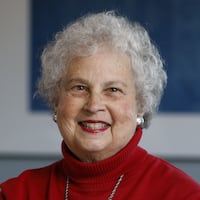The announcement was made on International Holocaust Remembrance Day, which coincided with the 80th anniversary of the liberation of Auschwitz. The exhibit is a collaboration between the Cincinnati Museum Center and the Nancy & David Wolf Holocaust & Humanity Center, both housed in Union Terminal.
“Auschwitz. Not long ago. Not Far Away,” features more than 500 original objects from the Auschwitz-Birkenau State Museum and more than 20 other international museums including Yad Vashem in Israel and the United State Holocaust Memorial Museum in Washington, DC.
It traces the rise of Nazi ideology and the transformation of Auschwitz from an ordinary Polish town into a place where “unimaginable atrocities and extraordinary human resilience intersected.”
Visitors will see hundreds of personal items that belonged to victims and survivors including suitcases, eyeglasses and shoes. Key artifacts include concrete posts that were part of the fence of the camp, fragments of an original prisoners barracks, Picasso’s “Lithograph of a Prisoner,” a desk and other possessions that reflect the world of the perpetrators including the first and longest serving camp commandant Rudolf Hoss.
Credit: Submitted.
Credit: Submitted.
Cincinnati competed with a number of other Midwest venues to host the final stop in the exhibit’s North American tour, according to Kara Driscoll of the Holocaust Center.
“It’s incredible and such a great opportunity to have it in the same building where Holocaust survivors came by train after the war,” she said. “ It gives you chills.”
Driscoll said 250-300,000 visitors are expected to view the exhibit, which will also include stories of local Holocaust survivors who came to Cincinnati after the war.
About Auschwitz
Of the 1.3 million people deported to Auschwitz, only 400,000 were registered and imprisoned; nearly 900,000 people were murdered within hours after their deportation with their baggage and belongings stacked for sorting and looting by the SS.
In total, 1.1 million people were systematically murdered at the camp including one million Jews. Tens of thousands of Poles, Sinti, Roma, Soviet POWs, Jehovah’s Witnesses and people deemed “homosexuals,” criminals” or “inferior” also lost their lives. On January 29, 1945, the Soviet Army liberated the 7,000 prisoners remaining in the camp. All other prisoners had been forced on death marches elsewhere.
Gary Hochstein, of Miami Twp., has a personal connection to the exhibit.
“My grandparents were originally from Poland and moved to Germany and lived in Cologne until the Nazis deported them to a refugee camp in Poland,” he said. “My dad was saved when he got on the Kindertransport to London at age 15. He never saw his parents again and we know that a lot of the people in that refugee camp were sent to Auschwitz and killed.”
Renate Frydman of Clayton also lost grandparents at Auschwitz who were killed when both were in their mid 60s. Frydman is the chair of Dayton’s Holocaust Education committee and the curator of the Holocaust Exhibit, "Prejudice & Memory," at the Museum of the U.S. Air Force in Dayton.
She recommends that everyone see the upcoming exhibit in Cincinnati.
“It is of primary importance to keep the memory alive and to remember those who perished there,” she said. “Those who survived only asked for their loved ones to be remembered.”
Credit: NYT
Credit: NYT
MORE DETAILS
The “Auschwitz. Not long ago. Not Far Away” exhibit is slated to be in Cincinnati from Oct. 18, 2025 through April 18, 2026. Group sales of 10 or more will be available immediately; individual tickets will go on sale in April.
About the Author



